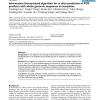Free Online Productivity Tools
i2Speak
i2Symbol
i2OCR
iTex2Img
iWeb2Print
iWeb2Shot
i2Type
iPdf2Split
iPdf2Merge
i2Bopomofo
i2Arabic
i2Style
i2Image
i2PDF
iLatex2Rtf
Sci2ools
BMCBI
2005
2005
Information theory-based algorithm for in silico prediction of PCR products with whole genomic sequences as templates
Background: A new algorithm for assessing similarity between primer and template has been developed based on the hypothesis that annealing of primer to template is an information transfer process. Results: Primer sequence is converted to a vector of the full potential hydrogen numbers (3 for G or C, 2 for A or T), while template sequence is converted to a vector of the actual hydrogen bond numbers formed after primer annealing. The former is considered as source information and the latter destination information. An information coefficient is calculated as a measure for fidelity of this information transfer process and thus a measure of similarity between primer and potential annealing site on template. Conclusion: Successful prediction of PCR products from whole genomic sequences with a computer program based on the algorithm demonstrated the potential of this new algorithm in areas like in silico PCR and gene finding. Background PCR technique is widely used in the molecular biology ...
| Added | 15 Dec 2010 |
| Updated | 15 Dec 2010 |
| Type | Journal |
| Year | 2005 |
| Where | BMCBI |
| Authors | Youfang Cao, Lianjie Wang, Kexue Xu, Chunhai Kou, Yulei Zhang, Guifang Wei, Junjian He, Yunfang Wang, Liping Zhao 0003 |
Comments (0)

